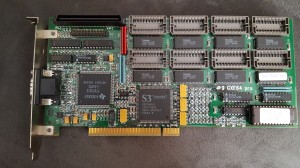GXe64 Pro 1600 PCI
The GXE64 Pro 1600 PCI was based on the same core graphics engine as the earlier GXE64 Pro, the S3 Vision964, but got a faster RAMDAC.
|
Released | 1995 |
| Bus | PCI | |
| Chipset | S3 Vision964 (86C964) | |
| Standards | MDA, Hercules, CGA, EGA, VGA | |
| Memory | 4 MB VRAM | |
| RAMDAC | Texas Instruments PTVP3025 (220 MHz) | |
| Ports | 9-pin DSUB (RGB analogue video out) VESA Advanced Feature Connector (VAFC) |
|
| Part # | ||
| FCC IDs | ||
| Price | At launch: | |
| See Also | Number Nine GXe64 Pro |
Board Revisions
Competition
In the Media
"The #9GXE64 Pro 1600 PCI is the odd one out among the four Number Nine cards we reviewed. Based on the older S3 Vision964 accelerator chip, the #9GXE64 Pro performs on a par with Number Nine's newer #9FX Motion771 graphics accelerator, yet it lacks that card's multimedia functions and costs $200 more. Given its somewhat pedestrian performance numbers and its inability to produce true color at resolutions higher than 1,152 by 864 pixels, the #9GXE64 Pro represents a questionable choice for Windows use.
The #9GXE64 Pro's shining moment is in its AutoCAD performance, however. On the 3-D Pan test, the card shot into first place; it took third place on our Redraw All test. But given the availability of more full-featured, less costly cards that incorporate later-generation accelerators, the #9GXE64 Pro would only make sense for someone who spends time in AutoCAD for DOS and doesn't need more than midrange Windows graphics performance.
Though the aging 64-bit S3 Vision 964 graphics accelerator is certainly nothing to sneeze at, this chip has been surpassed by later models from S3 and utterly outclassed by the latest chips from ATI Technologies and Matrox Graphics, and Number Nine. The S3 Vision 964 has all of the GUI features built into its core, including the ability to perform BitBlts, line draws, and pattern fills. What's missing is the video acceleration built into the Vision 968.
The 220-MHz Texas Instruments RAMDAC and 4MB of VRAM combine nicely with the S3 Vision 964 to deliver above-average refresh rates of 120 Hz at 1,024 by 768 at 24-bit color and 76 Hz at both 1,280-by-1,024 and 1,600-by-1,200 resolutions with 16-bit color.
The muscle behind the #9GXE64 Pro's impressive AutoCAD performance could well lie in its Number Nine-engineered PowerPac drivers. Where virtually every other card we saw came with a version of Panacea's TurboDLD drivers, the PowerPac suite leverages Number Nine's long experience with CAD. That the drivers make most of the difference in CAD performance is borne out by the card's poor performance on our Vector File Open tests: Here, the #9XE64 Pro limped to a tie for last place.
Windows graphics performance was a strangely mixed bag. Though the #9GXE64 Pro garnered squarely average marks for true-color 1,024-by-768 performance on the Winstone 95 and Graphics WinMark 95 tests, it shot up to third place on the Raster Rotate test at the same resolution and color depth. Interestingly, the #9GXE64 Pro outpaced Number Nine's Motion771 on our applications-based Winstone tests but was in turn bested by the Motion771 on the Graphics WinMark tests. These results would seem to indicate that the #9GXE64 Pro fares slightly better on real-world Windows tasks than the Motion771."
PC Magazine, 27th June 1995
The #9GXE64 Pro's shining moment is in its AutoCAD performance, however. On the 3-D Pan test, the card shot into first place; it took third place on our Redraw All test. But given the availability of more full-featured, less costly cards that incorporate later-generation accelerators, the #9GXE64 Pro would only make sense for someone who spends time in AutoCAD for DOS and doesn't need more than midrange Windows graphics performance.
Though the aging 64-bit S3 Vision 964 graphics accelerator is certainly nothing to sneeze at, this chip has been surpassed by later models from S3 and utterly outclassed by the latest chips from ATI Technologies and Matrox Graphics, and Number Nine. The S3 Vision 964 has all of the GUI features built into its core, including the ability to perform BitBlts, line draws, and pattern fills. What's missing is the video acceleration built into the Vision 968.
The 220-MHz Texas Instruments RAMDAC and 4MB of VRAM combine nicely with the S3 Vision 964 to deliver above-average refresh rates of 120 Hz at 1,024 by 768 at 24-bit color and 76 Hz at both 1,280-by-1,024 and 1,600-by-1,200 resolutions with 16-bit color.
The muscle behind the #9GXE64 Pro's impressive AutoCAD performance could well lie in its Number Nine-engineered PowerPac drivers. Where virtually every other card we saw came with a version of Panacea's TurboDLD drivers, the PowerPac suite leverages Number Nine's long experience with CAD. That the drivers make most of the difference in CAD performance is borne out by the card's poor performance on our Vector File Open tests: Here, the #9XE64 Pro limped to a tie for last place.
Windows graphics performance was a strangely mixed bag. Though the #9GXE64 Pro garnered squarely average marks for true-color 1,024-by-768 performance on the Winstone 95 and Graphics WinMark 95 tests, it shot up to third place on the Raster Rotate test at the same resolution and color depth. Interestingly, the #9GXE64 Pro outpaced Number Nine's Motion771 on our applications-based Winstone tests but was in turn bested by the Motion771 on the Graphics WinMark tests. These results would seem to indicate that the #9GXE64 Pro fares slightly better on real-world Windows tasks than the Motion771."
PC Magazine, 27th June 1995
Setting it Up
Downloads
Operation Manual Get in touch if you can provide this missing item! |
Original Utility Disk Get in touch if you can provide this missing item! |
|
